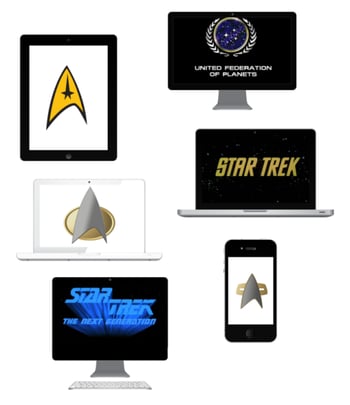Set Your Phasers to Stunning
Joe Mayberry#Industry Insights, #Design Advice

Star Trek has given us a lot of great ideas about the future, including how we design websites.
 Raise your hand if you are a Trekkie. ( If you're still in the closet about it, just kind of wave your hand under the desk—no judgment).
Raise your hand if you are a Trekkie. ( If you're still in the closet about it, just kind of wave your hand under the desk—no judgment).
No matter whether you loved Star Trek, hated it, or fell somewhere in between, there is no doubt that it had a huge impact on modern culture, society, and technology. In fact, when we look back on the multiple Star Trek television series, we can see that in many ways, they represented the zeitgeist of their eras, especially in the color choices and design aesthetics that were used in the sets and wardrobe.
From the primary colors of TOS (The Original Series), to the warm earth tones of TNG (The Next Generation), to the more minimalistic presentations of Voyager and Enterprise where everything was more functional and somewhat industrial, these shows truly represented the styles of the time.
Designing for the Future
One of the biggest challenges that the people working on Star Trek faced was how to know what the future was going to look like, and how it was going to work. But for all of their wild and crazy ideas, they still had to keep things rooted in the present. They had to pay close attention to their target audiences in order to bring the people in and get them to engage in this fantastic world.
Those challenges are very similar to what we face when building modern web sites. We all want to build a vision of the future, but trying to look forward 5, 10, or 15 years is a guessing game at best, especially where the web is involved. The best practices of today might be obsolete next year.
Star Trek did this by imagining a world where the impossible was an everyday occurrence, but here in the real world, we need to focus on understanding who the primary audiences are and craft an experience that will draw them in and engage them today and tomorrow. As designers and developers, we need to build sites that are easy to maintain and update as the technologies and audience needs evolve.
They Always Had the Coolest Toys
Star Trek was not just about the colors and designs. They came up with so many great ideas for technology that have become reality today. From the cell phones and flip phones inspired by the Star Trek communicators, to the modern smart phones and tablets that take the PADD (Personal Access Display Device) idea to whole new frontiers, Star Trek changed the concept of what interface design could be. They introduced the idea that software and graphical interfaces could take the place of physical knobs and switches. Data could be accessed wherever and whenever it was needed, regardless of the delivery method.
Real world devices like wireless connected tablets and smart phones have made it possible to have access to almost any data from almost any location. From Responsive Web Design that handles multiple screen sizes elegantly, allowing you to have one site on many devices; to JavaScript libraries that work asynchronously to manipulate data presentation; to more advanced back-end programming and data access techniques that allow us to process more data faster and more accurately; to emerging technologies like the internet of things, we have a huge opportunity to take that data even further.
It Looks Great! But Does it Work?
Star Trek had some amazing sets, and through the magic of television, the crew could make us believe that pressing a button on an empty box opened a communications channel with the neighboring ship or the planet below. It didn't really work, but that didn't matter.
But in the real world, we don't have TV magic. No matter how great and visually stunning a design might be in prototype form, when it comes time to create the actual product, we have to build underneath the pretty façade in order to make it work. Clicking a button has to do something, it needs to do the right thing, and it needs to do it quickly and efficiently. If it doesn't, then it's a failure.
Take a look at your own website. How well does the design handle different size screens? Are the buttons easy to use? Are you sending too much data back and forth between the device and the servers each time a new page is loaded? A poor implementation can be detrimental to a web site's success, and slow performing, non-optimized code can make even the best design a frustrating experience.
The good news is that there are now so many great tools and techniques available for modern web sites, that we can build some of the most functional, easy to use, and visually appealing sites out there. And what you will be able to do in the not-so-distant-future will make what we can do today pale in comparision.
So set your phasers on stunning, ahead warp factor 8, and Engage!
Related Posts
CMS Cloud Mastery: Overcoming Migration Challenges (Webinar)
Umbraco and Diagram have teamed up for a webinar on April 24th, 2024 at 12pm (ET) to discuss how to overcome cloud-based migration challenges. Register now.

Why Do I Need an SSL Certificate?
Without understanding what an SSL Certificate is, it may be hard to realize why this is so important for your website. In this blog Diagram will cover both of these topics.
Results Matter.
We design creative digital solutions that grow your business, strengthen your brand and engage your audience. Our team blends creativity with insights, analytics and technology to deliver beauty, function, accessibility and most of all, ROI. Do you have a project you want to discuss?
Like what you read?
Subscribe to our blog "Diagram Views" for the latest trends in web design, inbound marketing and mobile strategy.
